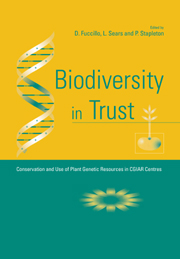Book contents
- Frontmatter
- Contents
- Preface
- Contributors
- Acronyms
- Chapter 1 Cassava
- Chapter 2 The Potato
- Chapter 3 Sweetpotato
- Chapter 4 Other Andean Roots and Tubers
- Chapter 5 Yams
- Chapter 6 Banana and Plantain
- Chapter 7 Cowpea
- Chapter 8 Chickpea
- Chapter 9 Groundnut
- Chapter 10 Lentil
- Chapter 11 Phaseolus Beans
- Chapter 12 Pigeonpea
- Chapter 13 Faba Bean
- Chapter 14 Soyabean
- Chapter 15 Barley
- Chapter 16 Maize, Tripsacum and Teosinte
- Chapter 17 Pearl Millet
- Chapter 18 Small Millets
- Chapter 19 Rice
- Chapter 20 Sorghum
- Chapter 21 Wheat
- Chapter 22 Forages
- Index
Chapter 12 - Pigeonpea
Published online by Cambridge University Press: 22 September 2009
- Frontmatter
- Contents
- Preface
- Contributors
- Acronyms
- Chapter 1 Cassava
- Chapter 2 The Potato
- Chapter 3 Sweetpotato
- Chapter 4 Other Andean Roots and Tubers
- Chapter 5 Yams
- Chapter 6 Banana and Plantain
- Chapter 7 Cowpea
- Chapter 8 Chickpea
- Chapter 9 Groundnut
- Chapter 10 Lentil
- Chapter 11 Phaseolus Beans
- Chapter 12 Pigeonpea
- Chapter 13 Faba Bean
- Chapter 14 Soyabean
- Chapter 15 Barley
- Chapter 16 Maize, Tripsacum and Teosinte
- Chapter 17 Pearl Millet
- Chapter 18 Small Millets
- Chapter 19 Rice
- Chapter 20 Sorghum
- Chapter 21 Wheat
- Chapter 22 Forages
- Index
Summary
BOTANY AND DISTRIBUTION
Pigeonpea, Cajanus cajan (L.) Millsp., belongs to the subtribe Cajaninae, tribe Phaseoloideae, subfamily Papilionoideae and family Leguminosae. It is an ancient cultivated crop with many vernacular and trade names in various languages and dialects. In India, it is called arhar and tur, in Portuguese guand and in Spanish guandu. The name pigeonpea was first reported from Barbados where the seeds were used to feed pigeons (Plukenet 1692). Van der Maesen (1986) has recorded over 300 names of pigeonpea. The important names include red gram, tur, arhar, guandul and pois d'Angole.
The plant is a perennial shrub, though in India it is usually cultivated as an annual crop. Pigeonpea has a deep root system which helps to withstand drought. The plant has a C3 pathway for carbon fixation, and interacts with cowpea strains of Rhizobium to fix atmospheric nitrogen. Most traditionally grown pigeonpeas have an indeterminate flowering habit. The inflorescences develop as axillary racemes from the branches and flowering proceeds acropetally. In the determinate types, the apical buds of the main shoots develop into inflorescences. Flowers are yellow with orange or red streaks, and the back of the corolla is fully red or orange. The flower has a typical papilionaceous structure with diadelphous (9+1) stamens, superior, subsessile or short, stalked ovary, long, filiform style with a terminal stigma. Pods are compressed, pubescent with a diagonal depression, 5-8 cm long and 1-5 cm wide. Seed number per pod varies from 2 to 9, but is usually 3 to 5.
- Type
- Chapter
- Information
- Biodiversity in TrustConservation and Use of Plant Genetic Resources in CGIAR Centres, pp. 156 - 167Publisher: Cambridge University PressPrint publication year: 1997
- 1
- Cited by

